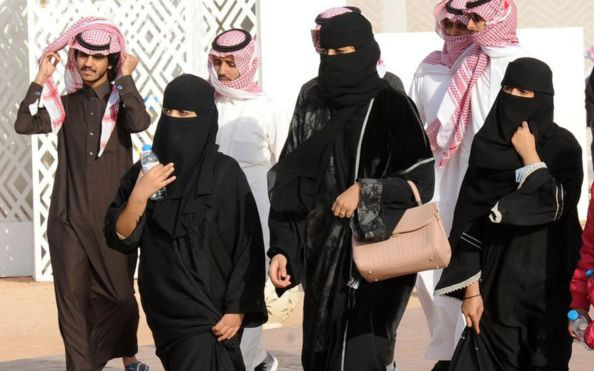Women in Saudi Arabia are protesting the tradition that Saudi women must wear a black abaya in public by wearing their abayas inside-out. This movement comes after Saudi Crown Prince Mohammed bin Salman (MbS) said, in a March 2018 60 Minutes interview, that Sharia law only requires women to dress modestly, but does not require a black abaya. Saudi women expected to see a lifting of restrictions on their way of dress following the Crown Prince’s public comments, but in the months after there have been no dramatic changes in favor of a freer dress code.
Women are reversing their abayas, a long loose fitting dress, in solidarity against the tradition of being forced to wear the modest garment when going out in public in Saudi Arabia. In recent years, women have also been defying the black color requirement by wearing more colorful abayas. Many of the protesters are turning to Twitter with photos using the hashtags #ForcedToWearIt and, in Arabic, “inside-out abaya,” to spread awareness. One Twitter user commented that she is protesting Saudi Arabia’s customs of being forced to wear the conservative clothes, especially in the workplace.
This campaign comes after MbS’s remarks on the subject of the abaya in March 2018, saying, “The laws are very clear and stipulated in the laws of Sharia: that women wear decent, respectful clothing, like men. This, however, does not particularly specify a black abaya or a black head cover. The decision is entirely left for women to decide what type of decent and respectful attire she chooses to wear.” This echoes what top cleric Sheikh Abdullah al-Mutlaq, a member of the Council of Senior Scholars, stated a month before in February 2018. Sheikh Abdullah said, “More than 90% of pious Muslim women in the Muslim world do not wear abayas. So we should not force people to wear abayas.”
MbS and Sheikh Abdullah’s recent public stance on abayas was a change of pace for the Kingdom. Under the strict watch of the religious police, also known as the Mutaween, dress-code, especially for women, was heavily enforced. An incident in 2002 highlighted the Mutaween’s priority of modesty over women’s lives when they barred girls escaping from a fire at their school because their hair was not properly covered, resulting in many deaths. In 2016, MbS retracted the religious police’s ability to arrest and interrogate, mainly in an act to consolidate power, meaning the need to wear an abaya in public is now only upheld by tradition.
The movement away from the abaya has been met with criticism, and many fear that too much freedom will lead to indecency, but this is not stopping women from wearing the abaya inside-out in protest. One medical student said, “I also don’t think that me not wearing an abaya makes me any less of a Muslim.” Women’s rights and the freedom to choose is the main message behind the protest. Saudi women deserve to be able to wear what they want, and while under Sharia law that requires them to be modest, there are more choices than just an abaya.
Caroline Hickey is an Advocacy Intern at ADHRB.





